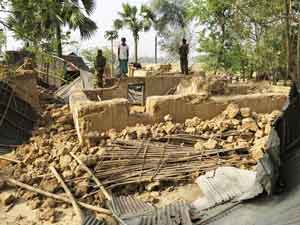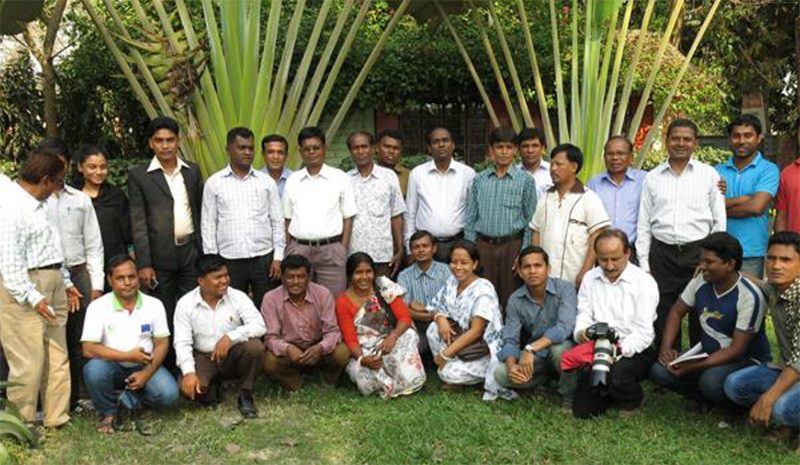
An eviction decree, its execution, and the fate of seven Mahle families
Philip Gain
It is like a scene of war-time devastation in a tiny Mahle village, Pachandor, in Tanor upazila (Rajshahi). Houses with thick mud walls and corrugated tin roofs have been leveled to the ground. Food grain, utensils, beds, clothes, cash, and other household materials are all broken and left mixed with mud. The families are left with nothing. They still have the courage to live around their homesteads in the hope of getting justice.
and corrugated tin roofs have been leveled to the ground. Food grain, utensils, beds, clothes, cash, and other household materials are all broken and left mixed with mud. The families are left with nothing. They still have the courage to live around their homesteads in the hope of getting justice.
The seven Mahle families, whose houses have been thoroughly destroyed in an eviction operation under a court decree report that they have been living on 32 decimals of land, vested property, for a hundred years.
Three brothers of the neighboring village, Sadipur—Fazlur Rahman, Estab Ali and Anisur Rahman—claim they own the land. “We bought the land in DAG No. 84 from Saber Ali Mondol,” claimed Anisur Rahman (65) youngest of the three brothers. “We have not done anything wrong in breaking the houses of the Mahles. We have won the case and got decree in our favor. The police and the court just assisted us to evict the illegal occupants.”
“This is ridiculous,” said Omor Faruque, councilor of Ward no. 1 of Mundamala Pourashava who came to the rescue of the houses from being destroyed but he was ignored. “The seven Mahle families had last taken yearly lease (DCR) in 2013, which means they are up to date with their lease.”
Two Karmakar families, close to the Mahle families also had their houses in DAG No. 94 partially destroyed.
The Eviction Operation
On the day of eviction, 30 March 2014, according to Johon Hasda (65), who now lives under the open sky with his eight family  members, reports, “A micro-bus carrying police stopped at our village in the morning. They were actually giving protection to the brothers (Fazur Rahman, Estab Ali and Anisur Rahaman) and around 150 men. Two more police van also arrived from Tanor Police Station. They started breaking our houses without paying any attention to our cries.”
members, reports, “A micro-bus carrying police stopped at our village in the morning. They were actually giving protection to the brothers (Fazur Rahman, Estab Ali and Anisur Rahaman) and around 150 men. Two more police van also arrived from Tanor Police Station. They started breaking our houses without paying any attention to our cries.”
Jastina Hembrom (35), standing in the middle of the debris on her homestead, cried and narrated what happened on 30 March: “We were in the field, harvesting wheat, when we heard that our houses were being demolished. We ran to the village. I saw my house being dismantled by around 35 people. I begged them not to destroy my house. I did not understand what to do. I begged them to give me a few days. But they did not pay any attention.”
“They did not even give us time we begged to move our paddy, rice and other household materials. Later on I found my four sacks of paddy, two sacks of wheat, two kuthis (home-made mud pot to store cereal) of rice scattered and mixed with mud,” said Jastina. She soon became busy with her brother-in-law’s 10-year old daughter Sriti, who got injured from a stone thrown at her. She remained in comma for three hours in a hospital.
Sicilia Hasda (35), another woman who witnessed her house destroyed gave further description of the appalling story. “I was working in the field when the news of demolition came. I ran to the village. I became so shocked to see some twenty people demolishing my house of mud walls with tin roof.
 “I was storing 14 maunds (one maund is equivalent to 40 kgs) of wheat, four maunds of mustard, and cash of Tk.5,000 of adivasi women’s organization, GOLAP, of which I am the cashier. I also had 20 maunds of paddy of my own. I begged them to allow me to enter my house. But they did not listen. I helplessly watched my house leveled to the ground. These foodstuffs and cash were all gone with my houses. The carnage went up to five in the evening.”
“I was storing 14 maunds (one maund is equivalent to 40 kgs) of wheat, four maunds of mustard, and cash of Tk.5,000 of adivasi women’s organization, GOLAP, of which I am the cashier. I also had 20 maunds of paddy of my own. I begged them to allow me to enter my house. But they did not listen. I helplessly watched my house leveled to the ground. These foodstuffs and cash were all gone with my houses. The carnage went up to five in the evening.”
What also astounded the Mahles and their neighbors was that they did not receive prior notice from the court before the decree of 2013 was executed.
The O.C. and the court representatives (Advocate Commission, surveyor, and Nazir) reportedly ignored the appeals of the Mahle people. “We have merely assisted in executing a decree from the court of law,” said S.M. Bazlur Rashid, O.C. Tanor Thana. However, there is allegation that Bangalees along with the Mahle who appealed to the police to spare the houses were threatened with arrest.
Quite a few social organizations organized human chains and road blockade on 31 March 2014 to protest against the eviction attempt. However, it was only on 21 April that Deputy Commissioner of Rajshahi, Mesbahuddin Chowdhury visited Pachondor, handed over three checks [Taka 3000 each) to three families and committed to give financial support of Tk.3,000 and 30 kgs of rice to each of the nine Mahle and Karmakar families.
The DC confirmed that the 32 decimals of land that the victims of Pachandor had their houses on is vested property. “It is government property and we will appeal to the court against the decree,” the DC reportedly said during his visit to Pachandor.
What Awaits the Victims of Pachandor
About a month has passed since the houses of the Mahle and Karmakar families were destroyed. The families, under severe  conditions, still continue to live guarding the debris of their houses and the land. They were terrified at the “atrocious” approaches of people who demolished their houses; but the tiny Mahle community remains bold and believe that they will get justice.
conditions, still continue to live guarding the debris of their houses and the land. They were terrified at the “atrocious” approaches of people who demolished their houses; but the tiny Mahle community remains bold and believe that they will get justice.
“We appreciate that the DC of Rajshahi has visited Pachandor and has committed some cash and food grain. These bring little relief. We demand that the seven Mahle families be rehabilitated on the land they have been living on for such long time,” says Rabindranath Soren of Jatyio Adivasi Parishad. “We also demand that the DC’s office quickly files the appeals against the decree and eventually gives permanent settlement of the land to the Mahle families because there is no trace of the original owner of the land.”
Joseph Mangra Murmu, one of the Mahle family heads says, “We are accepting the relief. But our main demand is that our houses are reconstructed and the land we live on are permanently settled to us.”
Writer is a researcher and director of Society for Environment and Human Development (SEHD).
http://www.dhakacourier.com.bd/?p=17095

